Knostrop Sludge Treatment Facility (2019)
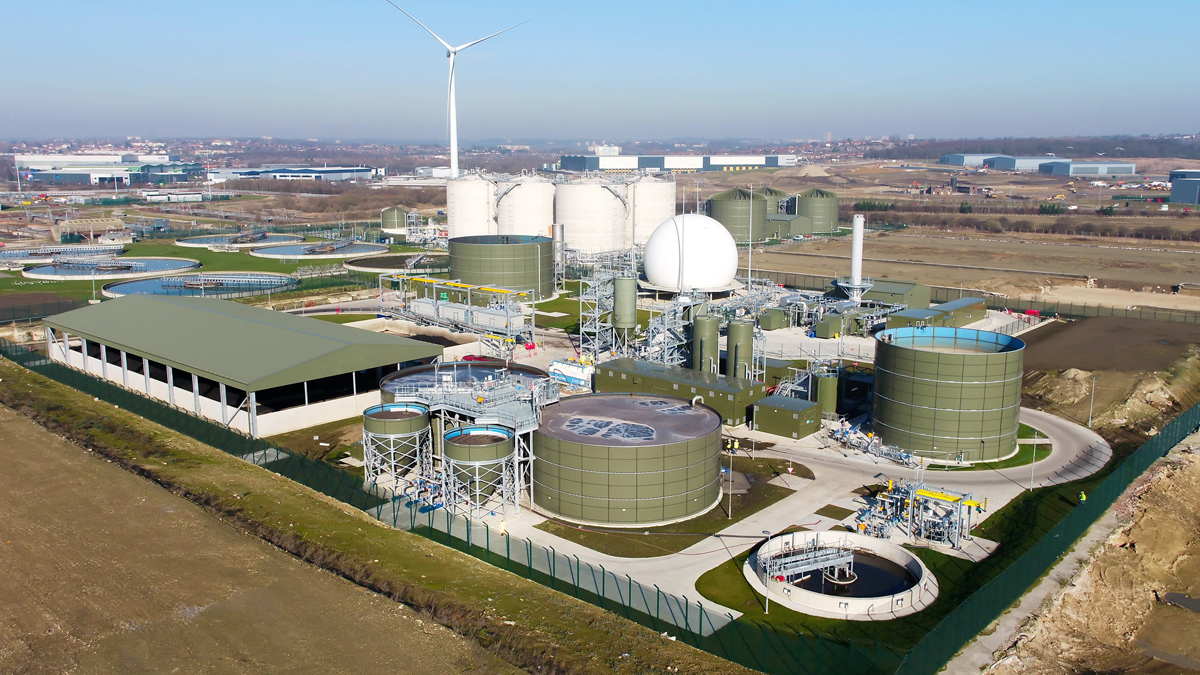
New sludge treatment facility - Courtesy of Black & Veatch
Over the last two decades the concept of municipal sewage being an expensive to treat waste stream has slowly become surpassed by renewable and sustainable opportunities that re-label wastewater treatment works as water resource recovery facilities (WRRF), sludge recycling centres (SRC) or sludge treatment facilities (STF) to name but a few. Incentivised by UK Government, the privatised water industry has predominantly been engaged in renewable schemes to recover energy from waste sludge that has traditionally been disposed of by spreading onto agricultural land. In parallel with renewable obligations, the water industry has been challenged to improve quality as well as reduce nutrient levels in effluent discharged to receiving watercourses, whilst reducing treatment costs through efficiency savings.
Background
The predominant technology adopted by all the UK water utilities for energy recovery from waste sludge is anaerobic digestion (AD) to produce biogas and the subsequent burning of the biogas as a fuel in combined heat and power (CHP) engines. Over the last 10 years Yorkshire Water have decided to move away from sewage sludge incineration.
Following a strategy review, Yorkshire Water Services (YWS) decided to progress with conventional mesophilic anaerobic digestion (MAD) plant at Knostrop STW serving the Leeds catchment. The change in treatment direction brings the benefit of renewable generation from biogas production and increased reliability and performance. The total cost for the project is £73m.
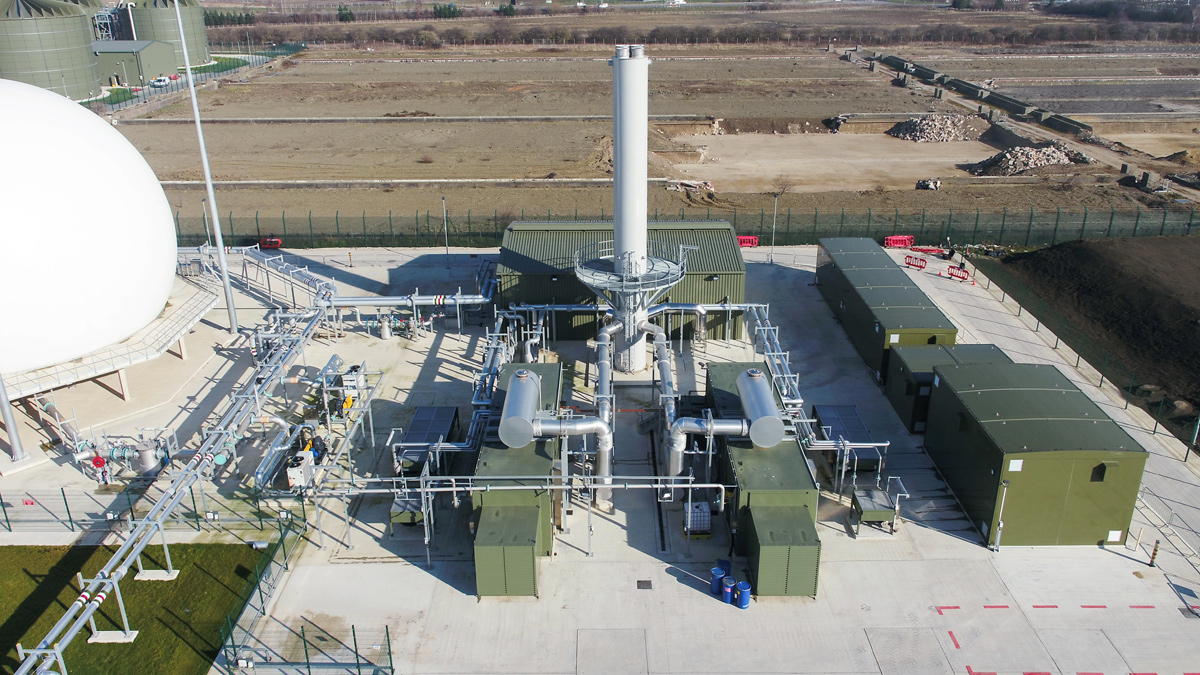
4MW CHP engines (installed capacity) – Courtesy of Black & Veatch
Project scope
Black & Veatch Ltd were selected by YWS to design, construct and commission the new Knostrop Sludge Treatment Facility in Leeds. The anaerobic digestion plant treats all the indigenous sludge (primary & SAS) from Knostrop WwTW. In addition, the site is a regional sludge treatment facility and receives imported sludge in both liquid and dewatered cake forms. The digested sludge is then lime sanitised to pH 9 and dewatered on site before being recycled as a soil conditioner.
At the time of writing (May 2019), the construction of the new plant is complete, and it has passed into the commissioning phase where the plant is currently undergoing performance testing and being prepared for hand-over from Black & Veatch to Yorkshire Water.
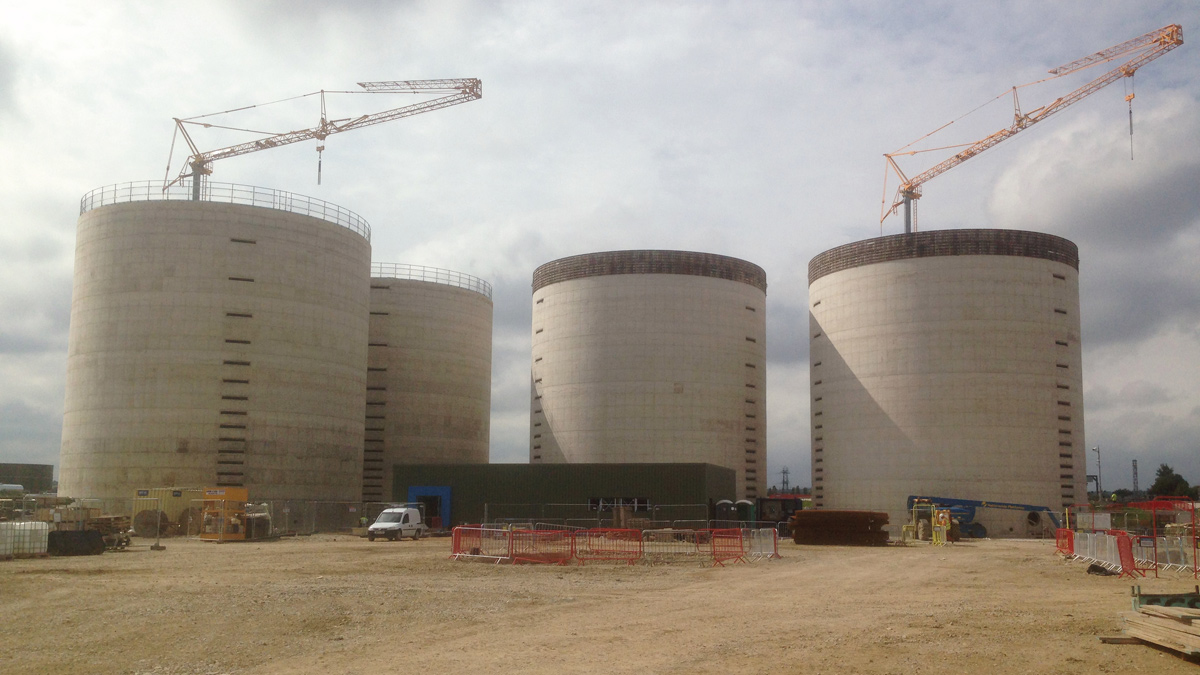
Digesters under construction – Courtesy of Black & Veatch
Knostrop STF utilises conventional mesophilic AD to treat indigenous and imported municipal sludges to produce biogas for 2 (No.) 2MW combined heat and power (CHP) engines. The heat from the engines (hot water cooling and exhaust heat) pass through heat exchangers to heat the sludge in the digesters to maintain an operating temperature of 36°C in the anaerobic treatment plant.
One consequence of AD biogas production is that proteinaceous nitrogen converts to soluble ammonium within the digestion process. This results in high ammonium loads being returned in liquors from downstream digestate dewatering processes, which adds to the ammonium treatment load received by adjacent wastewater treatment works (WwTW).
Liquor treatment plant
At Knostrop, following feasibility studies, it was decided to treat the concentrated ammonia liquors in a stand-alone liquor treatment plant (LTP). Liquor treatment plants have been commonly used to reduce the loads returning to the WwTW by using an aerated activated sludge process within a sequencing batch reactor (SBR) arrangement.
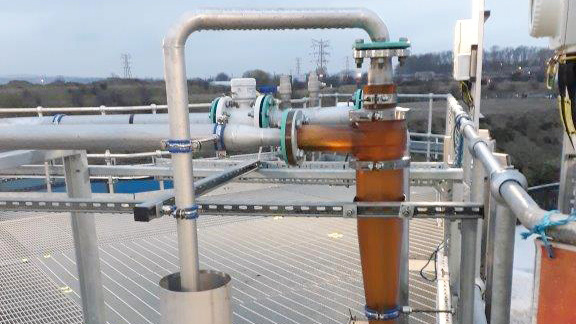
Cyclone removing excess anammox bacteria – Courtesy of Black & Veatch
Improved understanding of the biological processes within the nitrogen cycle has resulted in processes that short-circuit the conventional nitrification/de-nitrification route using alternative bacterial cultures such as anammox (anaerobic ammonium oxidation). The short-circuit reduces oxygen and carbon demands for the treatment of ammonium and therefore leads to a more efficient and cost effective LTP process.

Figures showing the anammox nitrogen conversion route and the red bead like annamox bacteria – Courtesy of Black & Veatch
The Demon® de-ammonification process, which was developed by researchers at the University of Innsbruck, was selected as the preferred process by Yorkshire Water at Knostrop STF for treatment of liquors from the anaerobic digestion thickening and dewatering plants prior to returning treated effluent back to the adjacent wastewater treatment works.
Black and Veatch (B&V) alongside SWECO (the exclusive UK licensee for the Demon® process) have designed, delivered, commissioned and operated the Knostrop Demon® LTP prior to take-over by Yorkshire Water.
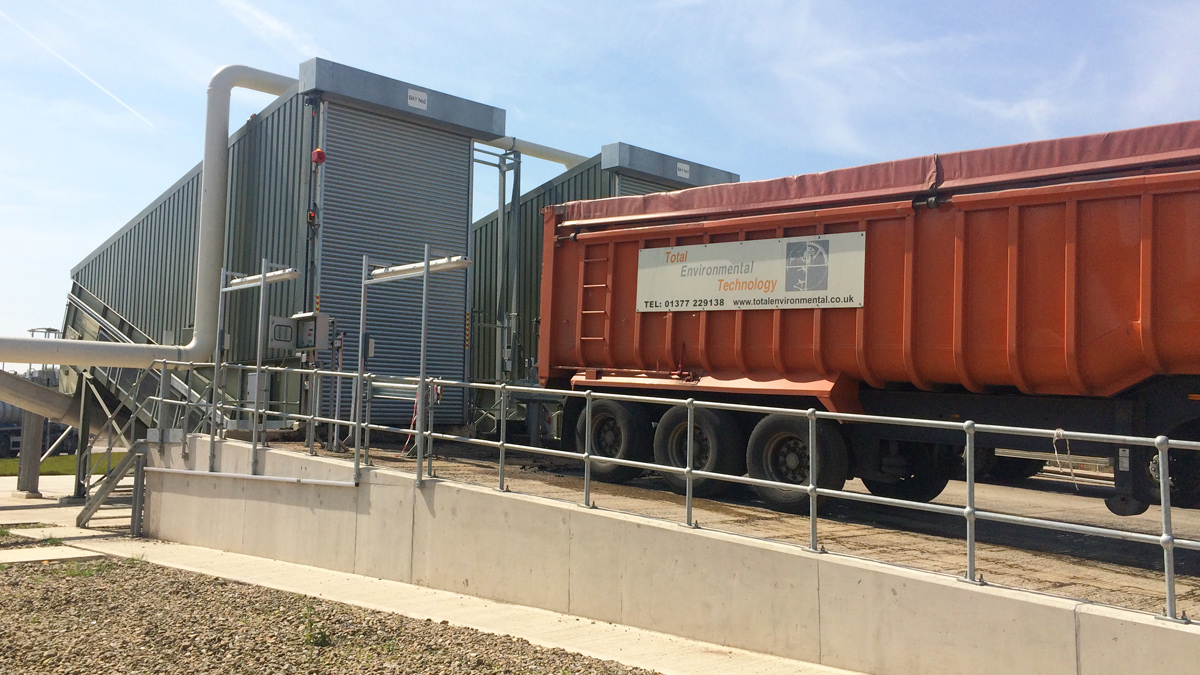
Cake imports to site – Courtesy of Black & Veatch
Demon® is a two-step process where oxygen is used to convert part of the ammonia into nitrite during the nitrification stages. This is followed by de-ammonification to convert the remaining ammonia and nitrite to nitrogen gas. The process is predominantly controlled by regulating the pH to control the reactions that bypass the de-nitification stage of the process.
The Demon® process is based on a biological process of nitritation and autotrophic de-nitrification. It uses small changes in pH to measure nitritation rate and feed of alkalinity. Aeration is stopped when sufficient NO2- has been produced for the de-ammonification process. Aeration is restarted when sufficient alkalinity has been fed into the system to recover pH.

Figure showing the reactions occurring in the Demon® reactor
Mixed liquors in the reactor overflow to a settlement tank (design up-flow rate 3m/h). Returned activated sludge (RAS) is returned to the reactor tank. Surplus sludge is taken via a cyclone directly from the reactor.
As alkalinity feed is proportional to liquor feed the aeration frequency is adjusted automatically to flow. As a result, the system reacts automatically to large variations in flow, or even interruption of flow, without the need for operator intervention. The system can run automatically and unattended with minimal supervision requirements.
The design characteristics of the Demon® plant at Knostrop, the UK’s biggest Demon® reactor are shown in Tables 1 and 2.
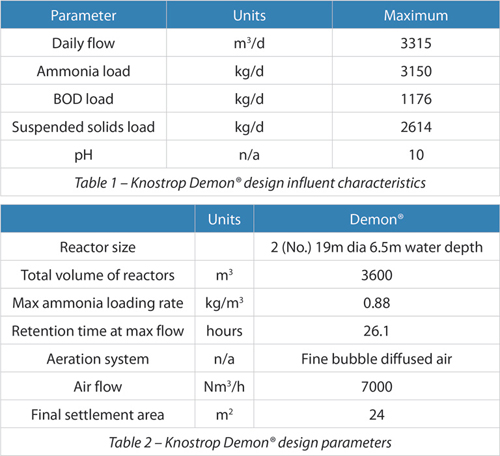
Tables 1 & 2
Progress
Sludge flow to the plant started in October 2018 and there has been a commissioning period of 6 months where the digesters were seeded from another plant and ramped up to full throughput. All the sludge from Knostrop site was diverted from incineration and temporary treatment by the start of 2019 and sludge liquid tankers and sludge cake lorries are being received at the site.
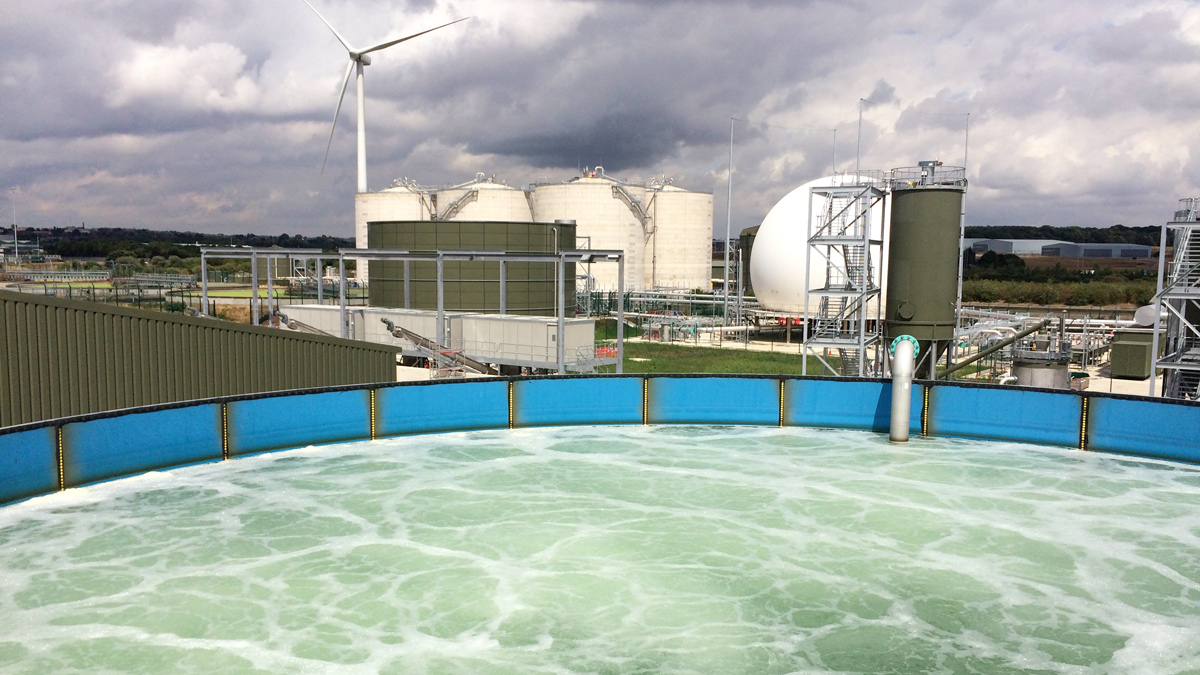
Knostrop LTP undergoing aeration testing – Courtesy of Black & Veatch
Since January 2019, the site has generated 6.28 Gwh of electricity and over the last month (March-April 2019) the average production has been 3.23 Mw (equivalent electricity used to supply to 6200 households). These are figures in excess of the design average and approaching the peak design. The ammonia treatment plant is removing ammonia to the levels required and overall the project has been a successful example of client and contractor working together to achieve a common goal.








